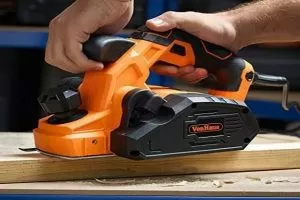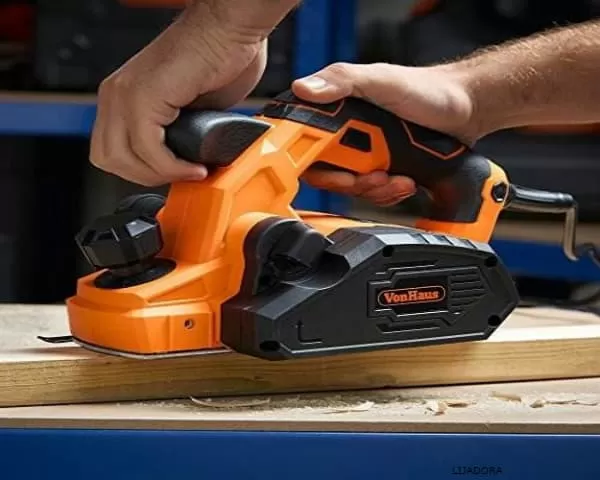Electric Planer in United State, Canada and United Kingdom
Electric planers provide powerful and precise material removal from doors and frames, as well as fast and efficient wood smoothing. Adjustable planing depths allow you to tackle a variety of tasks,
How Does a Planer Machine Work ?
Like the manual planer or electric planer it has blades mounted on a cutting head or drum that rotates at 20,000 rpm, eliminating wood equal to the difference in elevation between the front and rear shoes. The front handle doubles as a depth adjustment gauge. The gauge, with its built-in scale setting, moves back and forth to move the front planer shoe up or down.
Start by resting the front planer shoe on the wood without letting the blade touch the work. Start the tool, allow the motor to reach full speed, then bring the planer into contact with the work and push it firmly forward. The speed you push the tool and the depth setting you choose will affect the final smoothness of your work.
Hydraulic Planer
The planer is a machine that is used to generate precise flat surfaces and cut slots with the entire workpiece moving under the cutter. The worktable is moved back and forth on the bed under the cutter head by a hydraulic system.
Bench Top Planer in United State, United Kingdom and Canada
There are several types of bench planers Respectively, they are for the reduction (cut to length), initial smoothing, final straightening and smoothing of the wood. They are called bench planers because they are most often used on a woodworking bench rather than on site. Longer bench planers are usually used to straighten the wood; shorter ones are usually used for smoothing.
Hand Planer in United State, United Kingdom and Canada
Block brushes are smaller than most other brushes because they are designed to be held in one hand. Using a manual planer with the workpiece held in another hand
They can be used in a variety of situations where it is not convenient to place the workpiece in a vise or on a workbench. Instead, the workpiece can be held with the non-dominant hand while it is being brushed.
Industrial Planer Machine
It offers a new standard for heavy-duty planers. It has powerful motors, ensuring that you never run out of power even when brushing entire boards. The oversized bearing housings guarantee ultra-smooth, quiet performance and long life.
Planer/Thicknesser
Finally, we have the planer-assembler. This is simply a machine that incorporates the two previous types of machine, a planer-assembler on the upper surface and a planer-joiner underneath. It is easily identified by its square “box” appearance with the cutting mechanism running on the top face of the work piece. The thicknesser is used to create a level surface on old or irregular wood material.
Iron Planer
The iron planer has a fully adjustable blade that rests at 21 degrees Gray base, cast iron with precision sides and bottom Hand-held finger grips make it easy to use with one hand Hardened and tempered steel provides a durable precision cutter edge. Cutter adjusts for depth and alignment, offering precise control Durable epoxy coating for long-lasting protection Quick release cam lock makes it easy to remove iron
Planer Brands in United State and Canada
Einhell
The high-performance electric planer with 850 watts and an idle speed of 15,000 revolutions per minute is a high-quality power tool for demanding DIY enthusiasts for various precise operations with the electric planer.
The planer rests securely in the hand by means of the soft grip on the ergonomic main handle and can, thanks to the solid aluminium base plates, be guided effortlessly and evenly over the surface of the wood to be processed. With the large handwheel, the depth can also be adjusted very finely, so that a clean smoothing job can also be implemented.
Femi
The Femi surface planer is the smallest and most compact with a planing width of 158 mm and a planing width of 152 mm thick up to a maximum height of 120 mm.
Technical data
- Power 1250 W
- Table size 655×160 mm
- Parallel dimension 480×80 mm
- Knife dimensions 158 x 20 mm
- Adjustable disassembly 0-2 mm
- Maximum flush glide 158 mm
- Maximum thickness 152×120 mm
- Feed speed, planing, thickness 8 m / min
Vonhaus
Do light work on door fixing, wood assembly and correcting chips, splinters and deformed edges with the VonHaus planer. Extremely powerful, this 7.5A planer is capable of delivering an impressive 33,000 cuts per minute with a cutting width of 3 ¼ inches and a planing capacity of between 0″- 1/16″.
Main features
- Adjustable base plate with three chamfering slots to cut a 45° angle along a corner.
- Guide rail to maintain a straight cut
- Left/right dust extraction plus detachable dust bag that connects to the port to minimize clutter
- Depth adjustment dial.
- Add a 16,000 rpm drum speed to the mix, and you can achieve a smooth, professional finish every time
Bosch
It features a first brush lock button that helps prevent accidental starting and allows for prolonged operation. The dual-mount fence provides a non-bending guide; it prevents damage to the door or workpiece face.
Ball cord swivel joint makes it easy to position the cord to keep it out of the way Built-in spring mount raises the tool to protect the blade and save money. Powerful 6.5A motor with 16,500 RPM speed for fast material removal.
Dewalt
It features a three-blade cutting head and a powerful 15 amp motor delivering 10,000 rpm. It offers fast, accurate depth adjustment and the convenience of reversible and disposable knives. This full-featured planer makes it easy to create custom, clean stocks.
The dual speed gearbox is ideal for dimensional and finishing work. View larger. Powerful 15A motor for clean cuts Table top planers are a long term investment that allows you to save money over time by purchasing raw material and dimensioning it yourself.
Makita
The Makita planer offers power, cutting capacity and ease of use. It is ideal for professional building frames, window and door installation, and fine carpentry. The conveniently located on/off button can be operated from either side of the handle
Features
- Blade gauge assembly, wrench, ruler guide, depth guide and blade set
- Tool specifications.
- Planing width 3-1 / 4 “.
- Planing depth 5/32 “
- No load speed 16,000 RPM
- AMPS (120 V) 7.5
- Total length 11-3 / 8 “
- 7.5 AMP of power
Powerplus
This high quality combination planer is ideal for the serious carpenter’s workshop. You can plan precisely with this machine.
Technical specification:
- Motor: 1500 watt 230v
- Rotation speed: 9000rpm
- Number of cuts / min: 18000 cuts
- Feeding speed: 6 meters / min
- Maximum brushing width: 204 mm
- Maximum brushing depth – thickness: 0-3 mm
- Maximum brushing depth – brushing: 0-2 mm
- Equipped emergency stop button
- Supplied complete with pusher and dust extractor
Black and Decker
Eliminate the work of leveling and smoothing doors, window frames and other woodworking projects with this Black & Decker planer. It features a high-torque 5.2 amp motor for long life and deep cutting capability; 3-1/4 planing surface; 5/64 deep cutting capability that removes more material in one pass.
Locking button for convenience during extended use; 5/16 depth-of-back capability for edges; chamfering slot for decorative edges; and front depth-adjustment handle design for comfort and control. Includes 4 reversible carbide blades, edge guide, dust bag vacuum attachment.
Hitachi
The planer provides efficient cutting power even on the toughest jobs with a powerful 3.4 amp motor that generates a no-load speed of up to 15,000-RPM. The simple blade adjustment has a unique blade adjustment gauge for precise cuts. A center V-groove in the base allows for bevel cutting.
Rugged aluminum alloy base provides stable, scratch-free operation. With a no-load speed of 15,000-RPM, this tool will make setup easy. A lightweight 6.1 lb. design facilitates maneuverability and ease of use.
Triton
Patented 3-knife design and 10-position depth control knob for precise material removal Adjustable front handle with soft grip for comfort. Power indicator with power connection, ultra wide 7″ glide width, includes wrench, dust connector, tight guide and 3 x 65mm 180mm blades Cutting Capacities: 180mm width, 2mm depth No load speed 15000 rpm.
Features
- Powerful 1500 Watt motor for heavy-duty planing on the hardest wood surfaces
- Magnesium alloy for strength and durability.
- Non-slip rubber handle offers greater support, safety and control
- 3 blade drum design for faster, smoother cuts and superior finish
- Planing width of 180 mm / 7 “for maximum productivity
- Blades are reversible for long life
- Dust port for connection to a dust extraction system
Silverline
Net-fed with a sturdy cast iron base for precise and smooth brushing of wood and plastic surfaces. The adjustable fence tilts between 45° and 90° to accommodate complex material shapes. Built-in extraction port for efficient waste disposal. Emergency safety switch for user protection.
Anti-return device. Maximum brushing depth 3 mm. Max planing width 150 mm. No loading speed 12,000rpm. Built-in extraction port Anti-return device.
How to Make a Planer Tool ?
First choose a suitable type of wood, Alves is an excellent wood for making a brush, and so are apple, pear and hornbeam. The body of our finished brush will be approximately 3x3x12 inches long, so we will build it with a thinner material.
Since we are making a bench brush you will need several pieces of wood 3″ wide x 12″ long to achieve the shape. You will also need two pieces that are 3/8 to 1/2″ thick. The blade should be 1/16″ to 1/8″ wider than the flat blade. A 1/16″ is usually sufficient.
It is important that whatever wood you use is straight and flat, be even more meticulous about it, as any small mistake, oversight or compromise will manifest itself as a tool that is difficult to adjust and frustrating to use. Use quality glue and proper clamping pressure throughout the length of your pieces.
Once you have glued the center portion, make sure the top and bottom are square on the sides. This is very important for marking and creating the bench.
Make sure your blank is square on all 4 edges before you mark. Once you have glued your block, you will carefully mark everything, and then measure and cut the sides. This type of surface is not difficult, and I think it is the ideal technique to use. It gives you more flexibility in terms of the woods you can use.
How to Sharpen a Planer Blade ?
When you sharpen your blade, you are removing metal. Coarse grit sandpaper removes metal very quickly, but leaves scratches on the blade. Each successive finer grit also removes metal and leaves increasingly fine scratches on the blade. The polishing compound polishes the blade and will remove almost all scratches that make the blade sharp.
- Rub the blade and remove any traces of the paper shims. Paper shims are used to close the space between the blade and the aircraft body.
- Place a strip of 220 grit sandpaper on a flat surface. Keep bucket against sandpaper.
- Hold the brush bevel against the sandpaper and pull the entire length of the strip. The trick is to keep the bevel flatagainst the sandpaper and apply gentle pressure as you pull. Do this four or five times.
- Turn the sheet over and, with the beveled side up, hold the tip against the sandpaper with the other end slightly raised. Now pull the entire length of the strip four or five times.
How to Adjust the Planer Blades ?
You will also want to periodically check your blade, making sure that its bevel remains in good shape. Tilt it and turn it towards the light, noting how the light reflects off the bevel. If it is in good condition, it should look absolutely flat.
Related Products in ALPHAPEDIA
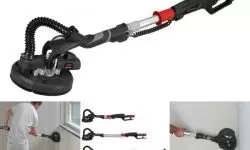
💚 WALL SANDER: ¿ How to Use It ? Brands and Models
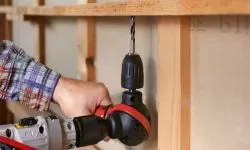
💚 WOODWORKING MANDREL: Brands, Types and Prices
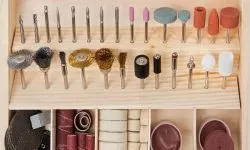
ACCESSORIES FOR Orbital and Drill SANDING MACHINES
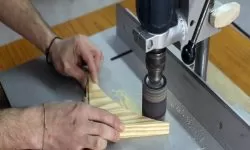
DRILL SANDER: How to Convert a Drill Into a Sander ?
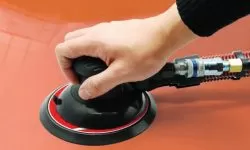
PNEUMATIC SANDER for Metal, With Vacuum. Its Prices and Brands
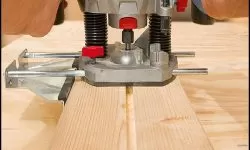
MILLING MACHINE: Types, Brands and Prices
Other Topics of Interest in ALPHAPEDIA

FREE BACHELOR DEGREE IN FORENSIC SCIENCE

FREE MASTER DEGREE IN ART HISTORY

HOW TO TIE MILITARY BOOTS ?

Receta de paella

DEUTERONOMY 18

FREE MECHANOGRAPHY COURSE
Planer Tool Image
